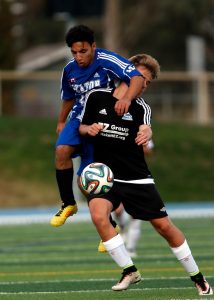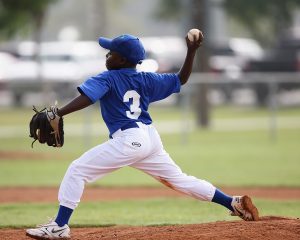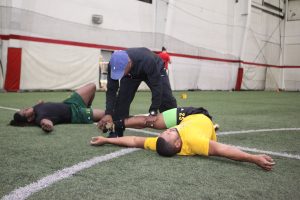Sports Injuries
Dear Parent of a Young Athlete,
Your kid got hurt playing sports. It happens. Now, what should you do about it?
While it’s true that sports injuries are common, there are two things I’d like you to consider:
- How did it happen?
- How is it being handled?
Some sports injuries are pretty much unavoidable if your kid is playing sports. Kids will fall, run into each other, or have a fluke accident occur. You take certain risks in sports, and this is one of them. If an injury occurs that you feel was simply part of the game, just move on to the second question and handle it in the best way possible.
Other sports injuries occur from overtraining, improper training/practice, or compensations that your child develops in order to keep up with the demands of the sport. These injuries need to be investigated differently.
If your child is suffering from repeated injuries that don’t seem like “accidents” or “part-of-the-game” things, there’s probably something else going on that needs to be addressed. It could seem like something relatively straightforward like an overuse injury, but simply resting until it feels better, then going right back to the same routine is a set up for re-injury. The volume of training might just be too high, but it could also be that your child’s mechanics (running, throwing, kicking, etc.) aren’t correct, which can cause all sorts of problems.
In these cases, mechanics should be addressed by a professional, or you run the risk of these injuries plaguing a child for a long time.
Sometimes, kids simply aren’t ready for the mechanics or demands of a sport. For example, most kids under 11 simply don’t have the ability to adequately control the pelvis during rapid spinal rotation. This is just part of the maturation process, and it kind of seems like a built-in governor, that keeps growing bodies from performing crazy athletic feats too early. Unfortunately, when kids are taught how to throw or kick really hard at a young age, they can develop issues at the shoulder, elbow, knee, and hip stemming from the inability to perform these actions efficiently. Because they can’t control that spinal/hip rotation, they figure out other ways to compensate in order to throw or kick really hard, and other areas of the body take the brunt of these forces.
 That’s why we see things like 12-year-olds getting Tommy John surgery or 13-year-old soccer players with hip dysplasia. These things are typically a result of athletes being pushed too hard, too early. They “appear” to be able to do things that they simply shouldn’t be doing yet, like throwing 80 MPH at 12 years old.
That’s why we see things like 12-year-olds getting Tommy John surgery or 13-year-old soccer players with hip dysplasia. These things are typically a result of athletes being pushed too hard, too early. They “appear” to be able to do things that they simply shouldn’t be doing yet, like throwing 80 MPH at 12 years old.
There can be all sorts of reasons for overuse sports injuries. Just be sure to look into what may have caused the injury, and try to address it before it happens again.
You should also know that “different” injuries are often “related.” What I mean is that it’s possible for a kid to start out with hip pain. He rests, it gets better, and he goes back to playing. A few weeks later, he has back pain. He rests, it gets better, he goes back. A few weeks later, he rolls his ankle. Something is going on here. It appears as though the injuries are unrelated, but there’s a good chance they are. A good therapist, doctor, or experienced strength coach may be able to figure out what’s happening through a comprehensive evaluation, and it’s important to address it before it becomes worse.
Sometimes, you’ll have to talk to a coach about what’s going on with your child. A coach who says it’s “my way or the highway” may not be a great partner when it comes to your child’s health. Now you’re dealing with politics, and you might have to tip-toe around things to ensure you’re prioritizing your child’s well-being. Most coaches know sports and care about kids, but very few are also medical professionals who know exactly how to handle injuries. It’s very important to work with coaches when possible and defer to their judgment on certain things. It’s also important to recognize when your child is in a dangerous situation, and you may have to step in to do what’s best for your child. This can get really tricky (and should probably be a separate letter), so let’s just hope your coach cares about your child’s well-being.
The second part of this injury equation is how the injuries are handled. Far too often, I see parents take kids to their pediatrician for orthopedic issues that the pediatrician simply isn’t trained to treat. This is NOT the pediatrician’s fault. They are amazing doctors, but their training probably wasn’t in orthopedic injuries. It’s the same reason you wouldn’t go to a podiatrist for a heart issue. Or you wouldn’t ask a basketball coach to correct your golf swing.
Find the expert for the specific issue you’re dealing with.
How do you find the right person? It’s important that you take charge of these situations by doing some research. Find someone in your area that knows a lot of other health care professionals, and ask for some guidance. Physical therapists and athletic trainers often know the experts in their area, so they are a great resource. Some strength coaches and primary care physicians are also great resources.
Just explain what the issue is, and ask if they know who the experts are. You can walk into any physical therapy clinic to ask questions like this, and they should be happy to help if they can. You can also call or stop into a doctor’s office. You might not see the doctor, but they’ll get a message and someone will offer help.
Don’t be scared to ask questions and find the right person. Too many people say things to me like “my neighbor is a ______, so I go to him/her for every issue.” Well, MY neighbor is an outstanding ER doc, but I didn’t go to him for my thumb surgery. Find the right person.
There are so many different injuries associated with sports, and they are definitely going to happen. When they do, just make sure you are covering all of your bases by looking into why the injury occurred and finding the right professional to address it.
I hope this helps keep your kids safe.
Sincerely,
Jim
 Jim Kielbaso is the President of the IYCA and Director of the Total Performance Training Center in Wixom, MI. He has authored multiple books, articles and training products and has spoken at events around the world. He holds a BS in Exercise Science, an MS in Kinesiology and has gone through multiple certifications through the IYCA, NSCA, NASM and more. Jim is a former college strength & conditioning coach and has trained thousands of athletes at every level of competition. He runs a successful NFL Combine training program in Michigan and has been hired as a consultant for major sports programs like the University of Michigan Football Program and the University of Kentucky Basketball Program.
Jim Kielbaso is the President of the IYCA and Director of the Total Performance Training Center in Wixom, MI. He has authored multiple books, articles and training products and has spoken at events around the world. He holds a BS in Exercise Science, an MS in Kinesiology and has gone through multiple certifications through the IYCA, NSCA, NASM and more. Jim is a former college strength & conditioning coach and has trained thousands of athletes at every level of competition. He runs a successful NFL Combine training program in Michigan and has been hired as a consultant for major sports programs like the University of Michigan Football Program and the University of Kentucky Basketball Program.
To learn more from Jim, check out the IYCA Certified Speed & Agility Specialist course. The CSAS is the most comprehensive and scientifically sound speed certification in the athletic development profession. It truly prepares you to teach and develop speed. Click on the image below to learn more.


